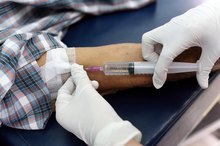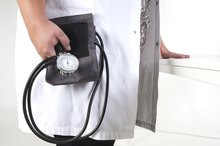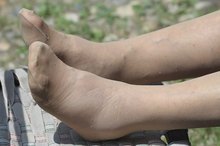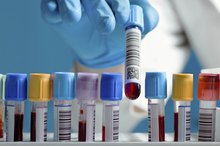What does fact checked mean?
At Healthfully, we strive to deliver objective content that is accurate and up-to-date. Our team periodically reviews articles in order to ensure content quality. The sources cited below consist of evidence from peer-reviewed journals, prominent medical organizations, academic associations, and government data.
The information contained on this site is for informational purposes only, and should not be used as a substitute for the advice of a professional health care provider. Please check with the appropriate physician regarding health questions and concerns. Although we strive to deliver accurate and up-to-date information, no guarantee to that effect is made.
How Long Does it Take DVT to Dissolve?
Blood clots can form in a vein deep in the body. The medical term is deep venous thrombosis (DVT).
If you are experiencing serious medical symptoms, seek emergency treatment immediately.
Description
Clots occur when the blood thickens at one or more places and clumps of cells form. Usually this happens in the lower leg or thigh. One or more clumps may break off and travel through the blood stream. If the clots block the lungs, this may cause a serious problem and can result in death. Clots in the lower leg are less likely to break off than clots in the thighs. While clots in a leg are most common, clots can form in other parts of the body.
- Clots occur when the blood thickens at one or more places and clumps of cells form.
- While clots in a leg are most common, clots can form in other parts of the body.
Signs and Symptoms
What Are the Treatments for an Arm Blood Clot?
Learn More
Only about half the people who develop deep vein thrombosis will exhibit symptoms. The clots may never cause a problem for some unaware of their condition. If the clots break off and travel in the blood stream to lodge in the lungs or heart, noticeable symptoms will appear.
If you notice a sudden onset of shortness of breath, pain with deep breathing, a fast heart rate or you begin coughing up blood, you need to seek immediate medical attention.
**If you do develop early symptoms of DVT, you will notice significant swelling of the affected leg.
** It may also become red and painful and may begin to feel warm. As soon as you realize what is occurring, get medical help right away to prevent serious complications.
- Only about half the people who develop deep vein thrombosis will exhibit symptoms.
- If the clots break off and travel in the blood stream to lodge in the lungs or heart, noticeable symptoms will appear.
Diagnosis
There are several ways in which DVT is diagnosed, but two are most often used.
A physician will examine your affected leg and determine if what she sees is likely to be the result of DVT. She will refer you to an ultrasound technician for an examination. Ultrasound uses sound waves to create a picture of blood flow. Clumped blood can be detected with this device. Another method is venography. A dye is injected into a vein and then an X-ray is done. A concentration of dye on the X-ray may indicate a clot.
- There are several ways in which DVT is diagnosed, but two are most often used.
- A concentration of dye on the X-ray may indicate a clot.
Treatment
Herbs for Dissolving a Blood Clot
Learn More
The goal of treatment is to prevent additional clotting, bigger clots forming and breaking off. Blood thinners, called anticoagulants, are the primary treatment.
Heparin, given by injection, usually begins treatment. Heparin is a fast-acting medication used to thin your blood. Warfarin (trade name Coumadin) takes several days to become effective.
When warfarin reaches the proper level, the other medication is stopped. Treatment with warfarin usually lasts from three to six months, during which blood tests for its level are done periodically.
More serious clotting may result in the use of blood thinners that are more potent, but increase the possibility of internal bleeding. Some patients require surgery to insert a filter device.
- The goal of treatment is to prevent additional clotting, bigger clots forming and breaking off.
- Treatment with warfarin usually lasts from three to six months, during which blood tests for its level are done periodically.
Preventive Treatment
Clots are not removed by medication. Over time, your body will usually dissolve some or all of the clots. However, some clots may remain for life.
Your physician may prescribe compression stockings to wear for six months to a year after medication is halted. The design of the stockings prevents blood from pooling in your legs. This helps reduce the incidence of further clotting.
- Clots are not removed by medication.
- Your physician may prescribe compression stockings to wear for six months to a year after medication is halted.
Related Articles
References
- MedlinePlus
- Andrade AR, Barros LL, Azevedo MFC, et al. Risk of thrombosis and mortality in inflammatory bowel disease. Clin Transl Gastroenterol. 2018;9(4):142. doi:10.1038/s41424-018-0013-8
- Faye AS, Wen T, Ananthakrishnan AN, et al. Acute venous thromboembolism risk highest within 60 days after discharge from the hospital in patients with inflammatory bowel diseases. Clin Gastroenterol Hepatol. 2019. doi:10.1016/j.cgh.2019.07.028
- American Society of Hemotology. Blood clots.
- Centers for Disease Control and Prevention. Data and statistics on venous thrombolism. Updated March 14, 2019.
- American Heart Association. Understanding your risk for excessive blood clotting.
- Kappelman MD, Horvath-puho E, Sandler RS, et al. Thromboembolic risk among Danish children and adults with inflammatory bowel diseases: a population-based nationwide study. Gut. 2011;60(7):937-943. doi:10.1136/gut.2010.228585
- Grainge MJ, West J, Card TR. Venous thromboembolism during active disease and remission in inflammatory bowel disease: a cohort study. Lancet. 2010;375(9715):657-663. doi;10.1016/S0140-6736(09)61963-2
- Nguyen GC, Bernstein CN, Bitton A, et al. Consensus statements on the risk, prevention, and treatment of venous thromboembolism in inflammatory bowel disease: Canadian Association of Gastroenterology. Gastroenterology. 2014;146(3):835-848.e6. doi:10.1053/j.gastro.2014.01.042
- Papa A, Gerardi V, Marzo M, Felice C, Rapaccini GL, Gasbarrini A. Venous thromboembolism in patients with inflammatory bowel disease: focus on prevention and treatment. World J Gastroenterol. 2014;20(12):3173-3179. doi:10.3748/wjg.v20.i12.3173
- Division of Blood Disorders National Center on Birth Defects and Developmental Disabilities, Centers for Disease Control and Prevention "Venous Thromboembolism (Blood Clots): Data & Statistics.” CDC.gov. 6 Apr 2017.
Writer Bio
Roy Sylvan has a Ph.D. in communication studies. He directed a large city department of aging, was COO of a consulting company and provided management training to companies and nonprofits. Writing for more than 40 years, Sylvan has authored articles in trade journals, magazines and blogs, and wrote a how-to book on starting a business.








